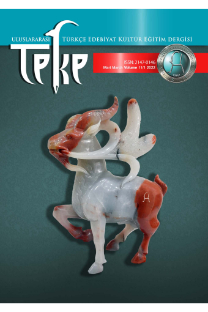DEDE KORKUT'TA ķanın-ķamın İLE İLGİLİ YAZIM, AKTARMA VE YORUM KARIŞIKLIĞI ÜZERİNE
Yazma eserlerde yazımla ilgili sorunlar söz konusu olabilmektedir. Yazıcıların birtakım kelimeleri yanlış, eksik veya fazladan yazması her zaman mümkündür. Filoloji ile uğraşan araştırmacının işlerinden biri de yazma eserlerdeki yazım karışıklıklarını tespit ederek metnin okunma sorunlarını çözmek ve doğru okuma şeklini ortaya koymaktır. Ancak bu konu son derecede dikkat ve özveri ister. Aksi durumda metindeki yazım yanlışları araştırmacıyı yanlış okumalara götürür. Bu nedenle araştırmacının sadece önündeki kelimeyi, ibareyi veya cümleyi incelemesi üzerinde kafa yorması yeterli değildir. Araştırmacının metnin neresinde hangi konuların anlatıldığını, yani bağlamı iyi bilmesi, metnin doğru okunması ve yorumlanması için son derece önemlidir. Bunu tamamlayan veya destekleyen diğer önemli bir nokta ise araştırmacının hangi kelimelerin metnin neresinde ve hangi anlamlarda kullanılmış olduğunu bilmesi, yani eserin diline hâkim olmasıdır.
REGARDING THE COMPLEXITY OF ORTHOGRAPHY, CONVEYANCE AND INTERPRETATION ON kanın-kamın IN DEDE KORKUT
On the manuscripts, problems with the orthography may come into question. It is always probable for the scribals to write some words incorrectly, deficiently or affluently. One of the occupations of the researchers dealing with Philology is to solve the reading problems of the text identifying the miswritings on the manuscripts and to put forward the correct way of reading. However this requires an uttermost caution and self- abnegation. Otherwise, the miswritings on the text lead the researcher to misreadings. Therefore, the reasearchers preoccupying him/herself with a focus only on the word, expression or the sentence in question is not adequate. It is of vital importance for the correct reading and interpretation of the text that the researcher knows what issues are discussed where in the text, that is context. Another significant point which is completing or supporting this is that the researcher knows which words are where and used in what sense in the text, that is to have a command of the texts language.
___
- DKH: GÖKYAY, O. Ş. (1995), Dede Korkut Hikâyeleri, Dergâh Yayınları, İstanbul. DKK: ERGİN, M. (1971), Dede Korkut Kitabı, Milli Eğitim Bakanlığı yayınları, İstanbul. Drs.: Dede Korkut Dresden nüshası. ERGİN, M. (1989), Dede Korkut Kitabı I (Giriş-Metin-Faksimile), Türk Dil Kurumu yayınları: 169, Ankara. KAÇALİN, M. S. (2006), Dedem Korkudun Kazan Bey Oğuz-nâmesi, Kitabevi, İstanbul. MEII: ERGİN, M. (1991), Dede Korkut Kitabı II (İndeks-Gramer), Türk Dil Kurumu yayınları: 219, Ankara. OŞG: GÖKYAY, O. Ş. (1973), Dedem Korkudun Kitabı, Milli Eğitim Basımevi, İstanbul. ÖZÇELİK, S. (2005), Dede Korkut Araştırmalar, Notlar/ Dizin/ Metin, Gazi Kitabevi, Ankara. ÖZÇELİK, S. (2006), Dede Korkut Üzerine Yeni Notlar, Gazi Kitabevi, Ankara. TEZCAN, S. - BOESCHOTEN, H. (2001), Dede Korkut Oğuznameleri, Yapı Kredi yayınları: 1441, İstanbul. TEZCAN, S. (2001), Dede Korkut Oğuznameleri Üzerine Notlar, Yapı Kredi yayınları: 1457, İstanbul. Vat.: Dede Korkut Vatikan nüshası.
- ISSN: 2147-0146
- Yayın Aralığı: Yılda 4 Sayı
- Başlangıç: 2012
- Yayıncı: Cengiz Alyılmaz
Sayıdaki Diğer Makaleler
ÖMER ZÜLFE’NİN ŞİİRİN İZİNDE SÖZÜN GÖLGESİNDE ADLI ESERİ ÜZERİNE
TEKE YÖRESİ EFSANELERİNİN YARATILMA ESTETİĞİ
İSMAİL BEY GASPIRALI’NIN ALİ MERDAN TOPÇUBAŞI’NA YAZDIĞI MEKTUPLAR
ÖMER ZÜLFE'NİN ŞİİRİN İZİNDE SÖZÜN GÖLGESİNDE ADLI ESERİ ÜZERİNE
HİLMÎ VE CİDÂL- İ ŞÂH ESʻAD BÂ- VEZÎR ADLI MESNEVİSİ
KAZAKİSTAN’DA BULUNAN KOYTUBEK YAZITINDA KÖKTÜRK YAZISININ ADI GEÇİYOR MU?
TARİH EĞİTİMİ VE VATANSEVERLİK ÜZERİNE BAZI DÜŞÜNCELER
İSMAİL BEY GASPIRALI'NIN ALİ MERDAN TOPÇUBAŞI'NA YAZDIĞI MEKTUPLAR
BATI EDEBİYATINDA TİYATRO ELEŞTİRİSİNİN GENEL SEYRİ
CEHENNEM VE TAMU KELİMELERİ ÜZERİNE ART ZAMANLI BİR DEĞERLENDİRME
